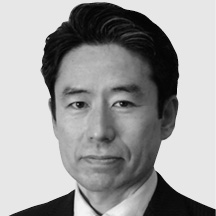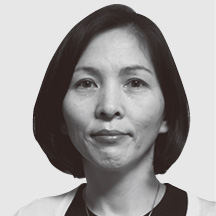Factors such as the rapid spread of IoT devices and advances in AI and big data are bringing major changes not just to corporate activity, but also to society itself. In the finance, social, and healthcare sectors, Hitachi is developing and delivering advanced technologies and solutions in an effort to build common platforms that are applicable across all of these sectors.

Strategy Planning Division, Systems & Services Business Division, Hitachi, Ltd. Current work and research: Development and deployment of business strategies for information & telecommunication systems.

Strategy Planning Division, Systems & Services Business Division, Hitachi, Ltd. Current work and research: Research and development, strategy development and deployment of information & telecommunication systems.

Business Development, Strategy Planning Division, Systems & Services Business Division, Hitachi, Ltd. Current work and research: Business development for overseas markets through alliances with global partners.

Business Development, Strategy Planning Division, Systems & Services Business Division, Hitachi, Ltd. Current work and research: Planning and promotion of new business development in the information and telecommunications field.
The advance of digitalization brings a variety of benefits as well as an acceleration of moves aimed at creating a sustainable society in which people are able to live safe, secure, and comfortable lives. In the midst of the Fourth Industrial Revolution, the Japanese government has taken the initiative by laying out a clear set of concepts in the form of its Society 5.0 vision for the society of the future. Embedded in Society 5.0 is a strong intention to lead the creation of a new society, one that represents the next step in the evolution of society through the hunter-gatherer, agrarian, industrial, and information era. A feature of Society 5.0 is that, rather than focusing solely on economic prosperity, it presents a national vision aimed at creating a new human-centric society, in the process overcoming a variety of societal problems that include the environment, the aging population and low birthrate, and urbanization.
A cabinet decision on “Growth Strategy 2017—Reforms to Achieve Society 5.0” was passed in June 2017 and intended as a practical measure for the creation of Society 5.0. It identified five key areas that play to Japan’s strengths: extending healthy lifespans, revolutionizing mobility, establishing a new generation of supply chains, user-friendly infrastructure and urban developments, and FinTech, a field that is transforming finance. Work is already getting underway, including in key areas that extend across different sectors such as human resource development and the establishment of platforms for the use of data.
Society 5.0 will bring major changes to industry and society in the form of a “digital transformation” (increasing digitalization) and will be implemented through the creation of new value that provides people with a better way of life. This powerful wave of digitalization is already extending beyond e-commerce to bring changes throughout society. The Internet of Things (IoT), for example, is enabling the collection and storage of data on everything from the movement of goods and people through to the activities of individuals in a range of industrial sectors, including healthcare, manufacturing, and energy. Advances in such digital technologies as artificial intelligence (AI) and big data analytics, meanwhile, have made it possible to use the collected data as a source of potential solutions that would have been overlooked in the past and to come up with disruptive services that transform people’s way of life. The trend toward the use of digital technology to generate new value and be of benefit to future society is taking place not only in Japan but also in USA, Europe, China, Asia, and other parts of the world.
However, set against the added convenience is the need for an awareness of the risks that arise from various different devices being connected together. This article will also address security and the privacy concerns that lie behind data.
Hitachi has for more than a century been extensively involved in the development of operational technology (OT) for social infrastructure. It also operates its Social Innovation Business that combines this OT with digital technology and information technology (IT), a field in which Hitachi has a history dating back more than 50 years.
Recent years have seen digitalization used in unique ways to satisfy customer requirements in systems and solutions supplied in various countries and regions. Moreover, as these systems are increasingly interconnected through the use of digital technology, it is anticipated that it will become possible to combine their different approaches and benefits and that this will lead to people enjoying safer lives with greater security and comfort. Providing the people of the future with a safe, secure, and comfortable way of life will require a transformation in the structure of society itself.
In 2016, Hitachi adopted a market-based corporate structure that strengthened customer-facing functions, identifying power and energy; industry, distribution, and water; urban; and finance, social, and healthcare as four key business sectors. This involves generating synergies in each of these sectors and working alongside customers on the collaborative creation of innovations, supporting them in everything from clarification of the issues through to value creation.
Helping bring about the human-centric society proposed by Society 5.0 is one of the major aims of Hitachi’s Social Innovation Business. Hitachi refers to this as its human-centered Social Innovation Business, the aim of which is to seek ways of ensuring the wellbeing of people, treating the end-users (people) as central and technology as ultimately just a tool.
This section presents examples of innovations achieved through digitalization, focusing on finance, social, and healthcare areas that are deeply intertwined with people’s daily lives.
Hitachi has many years of experience in the finance industry, supplying mission-critical systems for mega-banks, insurance and securities companies, and regional financial institutions. Drawing on this experience with system integration, Hitachi has taken heed of the trends toward digitalization and FinTech and has embarked on new initiatives in digital financial innovation that utilize advanced IT in the form of data analytics and AI. To provide examples of how digital technology is used, this section describes the application of dialogue AI to financial services, the use of medical big data to improve the business of life insurance, and the technology and applications for finger vein authentication that is able to use the visible-light cameras commonly found in mobile devices.
Hitachi believes that utilizing dialogue AI for activities at financial institutions can help with things like enhancing customer convenience and reducing staff workloads. Its use in a wide range of both front-end and back-end activities has the potential not only to reduce workloads, but also to help improve services. Examples include using speech to perform various procedures, replying to inquiries automatically, converting the minutes of meetings to text, and enabling hands-free data entry. While problems remain with dialogue AI, including response accuracy and maintenance requirements, Hitachi is developing ways of overcoming these with the aim of utilizing the technology to deliver innovations to customer businesses.
This joint research involves Hitachi utilizing its expertise to analyze information collected by the insurance business of Dai-ichi Life on customers’ state of health at the time of applying for insurance and their subsequent claims, using this to develop a model that predicts length of future stays due to lifestyle disease based on the applicant’s health at the time of application. The model has succeeded in increasing the number of new policy holders through its use to optimize Dai-ichi Life’s insurance acceptance criteria. Hitachi is also planning to utilize the know-how acquired from this joint research to establish a hospitalization risk simulation service for insurance companies.
While Hitachi has already developed technology that uses finger veins for biometric authentication, it utilizes infrared light and therefore requires a special-purpose sensor. To overcome this, Hitachi has now developed highly accurate finger vein authentication that uses the visible-light cameras commonly found in mobile devices. Use of this technique together with encryption techniques that Hitachi has built up in previous work makes it possible to deploy secure solutions for verifying identity in a variety of applications, including automatic payments, ticket-less services, and personal identity verification.
Japan’s aging population and low birthrate is starting to have repercussions right across society. In the case of roads and transportation, there are concerns about falling user numbers and a shrinking workforce, meaning that service providers in this area face the challenge of needing to improve efficiency while still maintaining and improving convenience for customers. The Society 5.0 vision being pursued by the Japanese government anticipates the development of advanced road traffic systems that can lead the way toward a “super smart society,” calling for the use of IoT data on roads and transportation.
Hitachi operates a service for utilizing transportation data that analyzes this IoT data, including things like probe data, to support improvements in operational efficiency and convenience for infrastructure users.
The core of this service is a transportation data analysis platform that uses the Lumada IoT platform. The transportation data analysis platform collects IoT data, including probe data and information on the points of departure and arrival for people and vehicles, and presents it to road and transportation operators using formats such as maps or graphs to show the results of multifactorial analyses of transportation demand, traffic conditions, and so on. By allowing infrastructure operators to utilize the data and analysis results in ways that suit their respective operations, this facilitate things like improvements in user convenience and the development of new services. Hitachi intends to help optimize all aspects of transportation by building on its services for using transportation data with a view to their being further developed into next-generation transportation services, otherwise known as mobility-as-a-service (MaaS).
Changes are also taking place in development practices and the way medical devices are being used in the healthcare sector, such as the increasing use of data to provide treatments that are tailored to individual patients. Hitachi has experience in dealing with healthcare stakeholders through a variety of channels, having also built up expertise in the use of data that draws on resources from across the group. This section describes what Hitachi has been doing to create new value through the use of healthcare data and its solutions that use digital technology to support diagnostic imaging.
For example, it is hoped that the analysis of data in many different forms based on clinical practice, including health insurance claim data, electronic medical records, and data from medical consultations, will benefit drug development by pharmaceutical companies and help with things like improvements in diagnosis accuracy and the control of healthcare costs at healthcare providers. In addition to providing a cloud-based data management service that uses a secured information management service called Tokumei Bank to support the use of healthcare data, which demands a high level of confidentiality, Hitachi is also contributing to the realization of patient-centric healthcare thorough involvement in many different applications for healthcare data, including the development of cancer prediction models and support for the use of genomic information.
To help with the early detection and diagnosis of disease, Hitachi is working to improve the efficiency and quality of all steps in the radiographic examination process through solutions that use digital technologies such as AI, big data analytics, and the IoT to support diagnostic imaging. Shortening scan times is an important aspect of diagnostic imaging, and Hitachi has developed a support function for magnetic resonance imaging (MRI) scan positioning to help make scanning more efficient. The quantitative susceptibility mapping (QSM) technique used in MRI works by visualizing differences in the magnetic susceptibility of tissues and has the potential to help with the early diagnosis of neurodegenerative disease. A system that uses AI to support the interpretation of computed tomography (CT) images is intended to improve the quality and efficiency of interpretation by combining expertise in deep learning with image processing techniques that Hitachi has acquired through its experience as a manufacturer of diagnostic imaging systems. The system is currently being prepared for clinical trials and Hitachi is also working on applying the technology to other systems and a variety of medical conditions.
Since 2011 when the use of big data became of interest as a business, technological advances in areas like the IoT, AI, and robotics have both dramatically increased the amount of data collected and lifted expectations for the use of different forms of data to create value and bring about the super smart society.
The “New Industrial Structure Vision” collated by Japan’s Ministry of Economy, Trade and Industry in May 2017 noted that use of data was essential for the establishment of new industry structure systems. However, of all the different forms of data that exist, the public have a particularly high level of interest in personal data and there is a need for privacy protection.
Hitachi’s Systems & Services Business Division is well aware that appropriate consideration for personal privacy is essential to the extraction of value from this personal data and is taking both active and proactive steps to protect privacy. What this has meant in practice is the establishment of bodies for dealing with privacy protection, specifically the appointment of people with responsibility for personal data and the establishment of an advisory committee on privacy protection, and also the preparation of privacy protection rules and manuals. Other activities include conducting awareness surveys and training where appropriate as well as assessing privacy impacts and implementing privacy protection measures in business processes and development activities. By utilizing and deploying the know-how derived from this experience in its business operations, Hitachi is supplying products, services, and solutions that take account of privacy protection.
Along with the rapid advance of digitalization, which includes the IoT, AI, and FinTech, customer needs are also shifting toward new business models and value creation. In response, Hitachi is devising innovative business models and increasing the pace of collaborative creation with customers in its advanced Social Innovation Business that serves as an innovation partner for the IoT era by consolidating knowledge and engaging in open innovation in ways that transcend the boundaries between organizations, industries, regions, and so on.
However far the digitalization of society progresses, it is people who generate value and come up with ideas in important areas and this will still be the case in a decade’s time. What Hitachi is seeking to achieve with collaborative creation can be thought of as being to find ways of ensuring the wellbeing of the people who are end users.